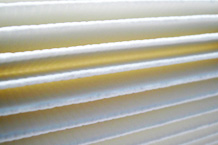Air Purifier Technology
Air purifiers employ what seems to be simple technology on the surface. Effective air purifiers draw from the room with a fan, clean the air, and send it back out into the room. There are a number of ways cleaning is performed while in the actual system. First there is adsorption. Adsorption uses a media like activated carbon or zeolite. These medias are porous so that the airflow is exposed to relatively large surface area. As the chemical contaminates come in contact with the media the chemicals combine the media and are thus removed from the room. Adsorption will remove chemicals and some parts of tobacco smoke and odors but has little impact on particles. The second approach is mechanical filtering much like your furnace filter. In this case the room air is screened of particles however, the screen is very fine.
An example of a very fine screen is a HEPA filter that removes particles as small as 0.3 microns. While air purifiers that use HEPA will remove particles like pollen and mold spores they has little effect on chemicals so this technology is typically used in combination with some form of adsorption filter. The third effective technology for air purifiers is electrostatic or now also known as electronic. These air cleaners use charged plates to give particles a charge of one polarity, positive for example, and a set of collecting grids or plates that have the opposite electronic charge, negative for example. As the charged particle nears the collecting grid it is drawn there by opposite charge on the collecting plate. As the particles build on the collecting plates the charging voltage will start to arc causing a popping sound. This is when you know it is time to clean the air cleaners plates in the dishwasher. Another effective albeit unique technology is a hybrid between HEPA and electronic. Blueair Air Purifiers uniquely use electrostatic brushes to charge the particles prior to being mechanically filtered. This allows the Blueair air purifiers to use HEPA with larger holes and thus get higher throughput. While not strictly a cleaning technology, in the strictest sense, we will address Ultra violet or UV light here. UV is a light that kills microorganisms such as bacteria and mold spores. This is always used in conjunction with other technologies employed in an air purifier.
Most all of the high-end air purifiers use some type of pre filter in addition to the filter elements mentioned above. The purpose of pre filters in air cleaners is to extend the life of the fine filter such as a HEPA element by removing large particles before they can get to the HEPA filter. You will typically find visible dust, hair, and lint in the pre filter. By keeping the pre filter clean you can dramatically extend the life of your HEPA filter and improve the overall efficiency of your air purifier. We will cover more on maintenance later.
We have focused the above discussion on effective systems and specifically ignored air purifier technologies that use or produce detectable levels of Ozone or other non-fan based technologies. These are generally bad for you. Please click on the Information button to see detailed articles addressing these non-effective air purifier technologies and detailed information about the effective air purifier technologies.




















Other variant is possible also